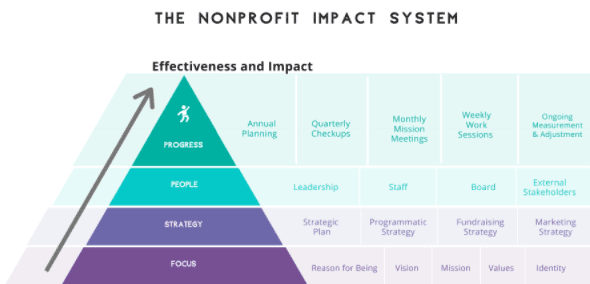The word “competition” can be a dirty one in the nonprofit sector. We’re collaborative. We work together to impact change. We have comparators (nonprofits that do similar work to ours), not competitors. This is true on many levels, working together is crucial. However, on the other side of the same coin, duplication can be detrimental.
There are 1.5 million nonprofits in the U.S. alone and more than 10 million nonprofits worldwide. These numbers don’t include the burgeoning for-profit social enterprise sector, also angling to do more good in the world. Differentiation is an important part of your nonprofit’s ability to raise more funds, recruit staff, reach the people who are in need of your services and drive mission impact.
That’s where focus comes in. Focus is about ensuring no other organization in your ecosystem is doing the work you do in quite the same way — your reason for being.
What does focus look like?
The more focused your team is on why your nonprofit exists and the change you’re looking to drive, the better everyone will be able to direct their efforts to what really matters. A focused organization with a clear reason for being intimately knows their greatest strengths and hones in on the areas where they are uniquely positioned to make the biggest impact. Those strengths are obvious to their clients, donors and funders, and they work hard to ensure collaboration, not duplication with other nonprofits in their space.

Focus is particularly important in times of crisis or with the uncertainty we’re experiencing with COVID-19. When you have a clear focus on your organization’s WHY, you can make decisions about how to adjust your efforts to meet people where they are, while still staying true to your mission. You’re seeing examples of this left and right: museums are livestreaming on Facebook, Meals on Wheels is changing to contactless delivery, and counseling organizations are conducting appointments via telemedicine.
[bctt tweet=”A focused organization with a clear reason for being intimately knows their greatest strengths and hones in on the areas where they are uniquely positioned to make the biggest impact.” username=”ProsperStrat”]Peer Health Exchange, a nonprofit devoted to advancing health equity, is another nonprofit leaning into their focus during this time. The organization trains college students to go into high schools to teach them about sexual health, substance abuse and mental health. They focus their work in low-income communities, where a majority of students have marginalized identities.
When schools across the country closed in March, Peer Health Exchange’s entire model was flipped upside down. At the same time, they knew that mental health needs were only going to increase among the young people they work with during this time of isolation.

Many organizations, like Peer Health Exchange, are being forced to adapt their programs and services. Those that have a clear focus are more easily able to reimagine how they bring their mission to life and meet people where they are in the COVID-era.
How do you find your focus?
If you haven’t clearly defined your focus at your organization, now is the time. This begins internally by identifying your organization’s greatest strengths. For Peer Health Exchange, they already had the resources and the network of college student educators, so all they needed to determine was the best way to reach the high school students they serve. Taking their efforts online was the obvious answer.
Once you’ve identified your nonprofit’s strengths internally, you’ll want to determine if your organization’s most important stakeholders also perceive them in the same way. You can do this through interviews, surveys, focus groups and even casual conversations.
Finally, you’ll want to look across your ecosystem at comparator nonprofits and determine how your work is similar or different from others in your space. This can be accomplished by reviewing websites and marketing materials as well as media coverage.
You’ll use your learnings to establish your organization’s unique reason for being and therefore the foundation of your focus.
Focus Starts With Our Nonprofit Strategy System™

